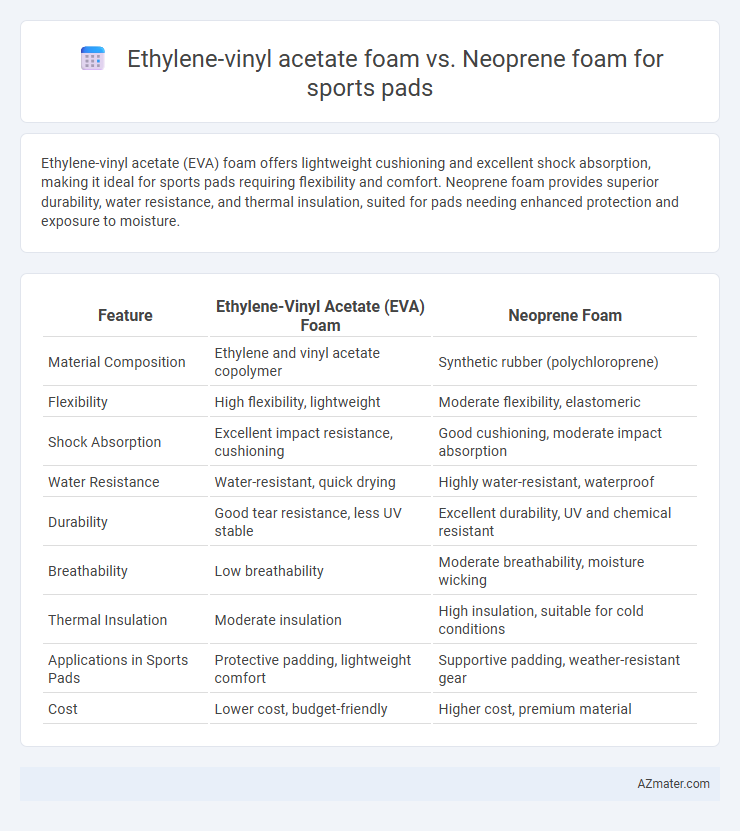Ethylene-vinyl acetate (EVA) foam offers lightweight cushioning and excellent shock absorption, making it ideal for sports pads requiring flexibility and comfort. Neoprene foam provides superior durability, water resistance, and thermal insulation, suited for pads needing enhanced protection and exposure to moisture.
Table of Comparison
| Feature | Ethylene-Vinyl Acetate (EVA) Foam | Neoprene Foam |
|---|---|---|
| Material Composition | Ethylene and vinyl acetate copolymer | Synthetic rubber (polychloroprene) |
| Flexibility | High flexibility, lightweight | Moderate flexibility, elastomeric |
| Shock Absorption | Excellent impact resistance, cushioning | Good cushioning, moderate impact absorption |
| Water Resistance | Water-resistant, quick drying | Highly water-resistant, waterproof |
| Durability | Good tear resistance, less UV stable | Excellent durability, UV and chemical resistant |
| Breathability | Low breathability | Moderate breathability, moisture wicking |
| Thermal Insulation | Moderate insulation | High insulation, suitable for cold conditions |
| Applications in Sports Pads | Protective padding, lightweight comfort | Supportive padding, weather-resistant gear |
| Cost | Lower cost, budget-friendly | Higher cost, premium material |
Introduction to Sports Pad Materials
Ethylene-vinyl acetate (EVA) foam offers lightweight cushioning and excellent shock absorption, making it ideal for sports pads requiring flexibility and comfort. Neoprene foam provides superior durability, water resistance, and thermal insulation, which benefits padding used in wet or cold conditions. Choosing between EVA and neoprene depends on factors like impact protection, environmental exposure, and the specific sport's mobility requirements.
Overview of Ethylene-Vinyl Acetate (EVA) Foam
Ethylene-Vinyl Acetate (EVA) foam is a lightweight, flexible material widely used in sports pads for its excellent shock absorption and cushioning properties. Its closed-cell structure provides durability, water resistance, and resistance to UV radiation, making it ideal for high-impact protective gear. EVA foam offers superior comfort and flexibility compared to neoprene foam, which is denser and less breathable, enhancing athletic performance and injury prevention.
Key Properties of Neoprene Foam
Neoprene foam offers superior elasticity, excellent impact absorption, and high chemical resistance, making it ideal for sports pads requiring durability and comfort. Its closed-cell structure provides water resistance and thermal insulation, enhancing protection during intense physical activities. Compared to ethylene-vinyl acetate foam, neoprene foam maintains performance under varied environmental conditions, ensuring long-lasting support and cushioning.
Cushioning Performance: EVA vs Neoprene
Ethylene-vinyl acetate (EVA) foam offers superior cushioning performance in sports pads due to its lightweight structure and excellent energy absorption, reducing impact forces effectively. Neoprene foam provides moderate cushioning with better flexibility and durability but tends to be denser and less shock-absorbent compared to EVA. For athletes requiring maximum impact protection and comfort, EVA foam is generally preferred, while neoprene is suitable for applications demanding enhanced durability and a snug fit.
Durability and Longevity Comparison
Ethylene-vinyl acetate (EVA) foam offers superior resistance to cracking and UV degradation, making it more durable and longer-lasting for sports pads subjected to intense physical activity and outdoor conditions. Neoprene foam provides excellent flexibility and water resistance but tends to deteriorate faster under prolonged exposure to sweat, heat, and abrasion. Overall, EVA foam is preferred for extended durability and longevity in high-impact sports padding applications.
Comfort and Flexibility in Sports Applications
Ethylene-vinyl acetate (EVA) foam offers superior cushioning and shock absorption, making it ideal for sports pads requiring enhanced comfort during high-impact activities. Neoprene foam provides excellent flexibility and resilience, conforming closely to the body for improved movement and support in dynamic sports applications. Both materials are widely used, but EVA foam is preferred when prioritizing softness and impact damping, whereas neoprene excels in elasticity and durability for prolonged use.
Water and Sweat Resistance
Ethylene-vinyl acetate (EVA) foam offers excellent water resistance and quick drying properties, making it ideal for sports pads exposed to sweat and moisture. Neoprene foam provides superior sweat resistance due to its closed-cell structure but tends to retain more moisture, requiring longer drying times. Both materials offer durability and shock absorption, but EVA foam's hydrophobic nature enhances comfort and hygiene during intense physical activity.
Weight and Mobility Considerations
Ethylene-vinyl acetate (EVA) foam is significantly lighter than neoprene foam, enhancing overall mobility and reducing fatigue during sports activities. Neoprene foam, while denser and heavier, offers superior cushioning and support but may slightly restrict movement due to its weight. Choosing EVA foam for sports pads optimizes agility and speed, whereas neoprene prioritizes durability and impact absorption.
Cost-Effectiveness Analysis
Ethylene-vinyl acetate (EVA) foam offers a cost-effective solution for sports pads due to its lower production costs and versatile cushioning properties compared to neoprene foam. Neoprene foam, while providing superior durability and thermal insulation, generally incurs higher material and manufacturing expenses, impacting overall affordability. Evaluating long-term use, EVA foam balances affordability with adequate performance, making it the preferred choice for budget-conscious sports equipment manufacturers.
Conclusion: Choosing the Ideal Foam for Sports Pads
Ethylene-vinyl acetate (EVA) foam offers superior shock absorption and lightweight properties ideal for high-impact sports pads, while neoprene foam provides excellent flexibility, durability, and water resistance suited for wet or cold conditions. Selecting the ideal foam depends on specific sport requirements: EVA is preferred for sports demanding enhanced cushioning and agility, whereas neoprene excels in environments requiring thermal insulation and stretchability. Understanding the distinct benefits of EVA and neoprene ensures optimal performance, comfort, and protection in sports padding applications.

Infographic: Ethylene-vinyl acetate foam vs Neoprene foam for Sports pad
 azmater.com
azmater.com